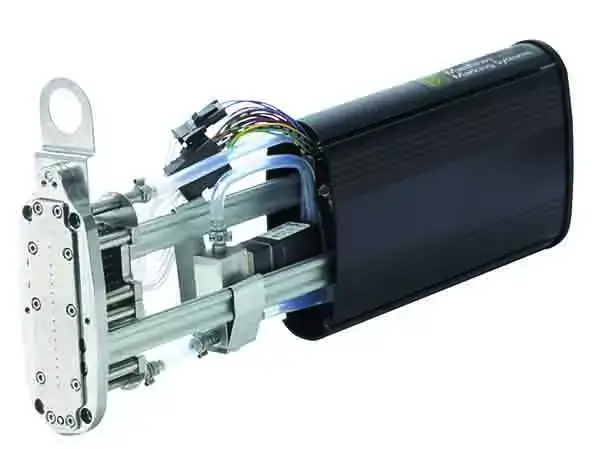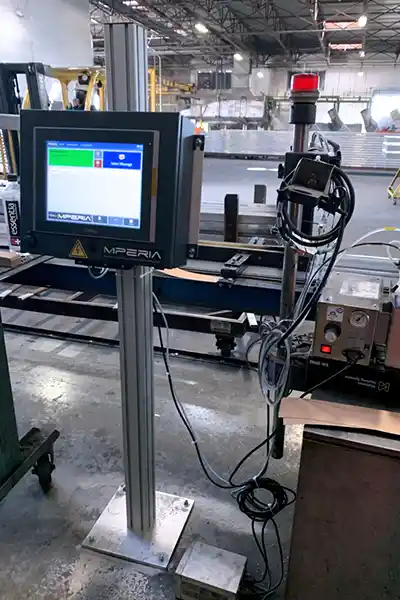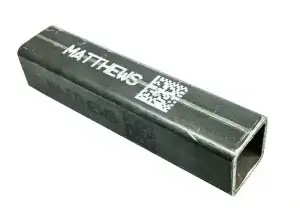Why valve inkjet is the number one technology for metal marking
By Kevin Havre
For marking on steel and aluminum, only one inkjet technology is up to the task. Everything else? Not so much…
The biggest challenge that that metal manufacturing companies face is universally harsh environments. Dust, heat, humidity – these conditions present major challenges for all inkjet print technologies.
That is, all except for one: Valve inkjet.
Where other printers struggle with illegible marks, machine failures and increased operational inefficiencies, valve inkjet printers offer outstanding reliability, durability, and efficiency in some of the harshest production environments on the planet.
So, what is it that makes valve inkjet technology stand out from the rest?
To understand the scale of its superpowers, let’s look at the unique challenges of metal manufacturing environments.
The battle against dust, oil, and heat
Metal manufacturing facilities are far from the perfect environment for precise marking. Plants are typically not temperature controlled, meaning you need a marking system that can operate under extremely hot, cold, and humid conditions. And it’s not only extreme plant temperatures that create challenges – oily and dusty surfaces cause reliability and quality challenges for many printer technologies.
Take continuous inkjet (CIJ) printers, for example.
CIJ can’t deal with big changes in temperature and humidity. This is because temperature and humidity changes cause ink viscosity changes, and these variations mean CIJ printers cannot produce consistent ink droplets. The result? Low quality marks.
As if that’s not enough to manage, uneven surfaces, coatings, and imperfections make it tough to achieve consistent marks and can result in inconsistent and unreliable printing, especially as you make production changes.
These conditions can create an unsurpassable challenge for traditional marking systems, like CIJ.

Valve inkjet: The technology made for the metal industry
Valve inkjet printers work by propelling pressurized ink through precisely sized nozzles toward substrates. Controlling the jets are valves that open just long enough to release a droplet and close. And a pressurized supply system provides a constant flow of ink with no wastage.
Let’s take a look at how this benefits metal manufacturers:
1. There’s no chance for internal contamination
The mechanical valves only open long enough to fire a droplet of ink onto your substrate. This means there’s no chance for dust or particles to enter internal components.
By contrast, in a CIJ printer, ink flows continuously, and only a few droplets are re-directed electrically to create marks. This exposes ink to the environment throughout the printing process, which means there’s more chance of dust and particles getting into the machine and causing issues. As Sierra Aluminum discovered, this means CIJ printers lack the reliability necessary for industrial marking applications.
2. You get better, higher quality marks
Valve inkjet technology has larger dot sizes than other inkjet technologies. This is more significant than you might think – larger drops can better absorb small dust particles or debris that can accumulate in front of the nozzles and remove them from the printhead.
Without the build-up that would otherwise clog most printheads, the line of fire remains clear. Valve inkjet printheads can be covered in dust and debris – a common occurrence in many metal manufacturing facilities – and still produce high-quality marks.
3. Experience dramatically longer life from durable printheads
On this front, the Matthews V-Series leads the industry – our printheads are rated for over 9 billion firings before maintenance is required. This rating holds even for harsh environments such as steel and aluminum manufacturing. The V-Series features a patented printhead and plunder design that far exceeds the rest of the industry for performance and reliability.
4. Lower maintenance all around
With a harsh environment, you’d expect any marking technology to need constant maintenance and put a demand on resources. But that’s not the case with valve inkjet printers. They do not require ongoing maintenance other than daily flushing of the valves or at the end of a shift or production run. Better still, their modular design means onsite operations staff can easily maintain and replace individual parts like printheads or pumps by connecting a few hoses and cables – no need for service contracts.

Matthews valve inkjet printers use bulk ink supply systems that are available in 1- and 4-liter bottles, 5-gallon pails, 55-gallon drums and 275-gallon totes — essentially eliminating the need for production staff to monitor and replenish ink during normal operation.
5. Big, bold, versatile marking
Compared to contact printing or CIJ printers, valve inkjet technology provides a bigger, bolder, and more versatile mark.
Contact printing often leads to smearing and other quality problems. At the same time, CIJ technology is limited in terms of character size, making it poorly suited to applications where workers need to identify products quickly from a distance.
MPERIA V-Series: Proven in the harshest environments
When it comes to marking for the steel and metal industry, the MPERIA V-Series ticks all the right boxes.
Whether printing thickness measurements on hot stainless steel as it comes out of processing or marking regulatory information on metal, V-Series valve inkjet printheads are up for the challenge. They can achieve high-quality marks while offering one of the fastest printing speeds in the industry at up to 780 feet per minute.

Sierra Aluminum has experienced the benefits of the V-Series firsthand. The company’s existing CIJ solution was not sustainable for metal marking. It wouldn’t perform reliably in the plant’s harsh environment, and there were times when the company couldn’t fulfill customer orders because the printers were not working. Further, they couldn’t rely on it to produce a quality mark consistent with Sierra Aluminum’s brand reputation. The delays caused by malfunctions, together with marking inconsistencies, were hurting its customer relationships and becoming damaging to its brand.
The company chose the Matthews Marking Systems’ V-Series valve inkjet printer with the MPERIA® automation platform. This delivered:
- 50% greater line efficiency
- Substantially lower maintenance costs
- Decreased ink costs
- Centralized control of print production
Selecting the right ink is critical for metal marking, which is why V-Series inks come in various pigmented, dye-based, and fluorescent inks. Matthews Marking Systems has advanced inks for marking metal, that can penetrate lubricants, coatings, and mill scale and withstand 200°C (392°F) temperatures to create clear, crisp marks with virtually no waste.

High contrast inks are also available for marking on dark metals. When a California-headquartered manufacturer of steel structural tube and pipe was looking for a solution to mark 2D codes and alpha-numeric characters onto the sides of its steel tube products, Matthews recommended adding a V-Series with a 32-valve printhead and high-contrast SCP-800A white pigmented ink. The white ink is printed directly onto the tubes, providing clear contrast and highly legible marks against the dark steel substrate.
See how valve inkjet printers can take your metal marking game to the next level with a free onsite consultation and demo. Contact us at +1 800-775-7775 or fill out the quick form below.
About the author
Based in Matthews’ Wilsonville, Oregon office, Kevin Havre is a global product manager for Matthews Marking Systems where he is focused on aligning products with customer needs and driving business strategies for key products and industries. Prior to joining Matthews, he served as a product line manager for Mobile Technologies, Inc. (MTI) with a focus on mobility products. He previously spent more than 10 years at Intel in various product management and strategic planning roles. Additional career stops have included Media Ring, Hewlett Packard and SAVO Electronics. He studied computer science at Oregon State and Washington State universities. In the winter months, you’ll often find him rescuing stranded or injured skiers from the slopes of Oregon’s Mt. Hood where he volunteers as member of the local ski patrol.
